RMIT Procurement Management: Single vs. Multiple Sourcing Strategies
VerifiedAdded on 2023/06/03
|15
|3155
|100
Report
AI Summary
This report examines the strategic sourcing decisions of organizations, specifically comparing single and multiple sourcing strategies within supply chain management. The analysis incorporates three case studies and three research articles, including discussions on the advantages and disadvantages of each approach. The report highlights the importance of strategic sourcing for efficiency and quality, emphasizing the collaborative nature of aligning purchasing power with overall value propositions. The literature review explores the complexities of sourcing strategies, considering factors such as supplier relationships, risk management, and the impact on inventory and market dynamics. The comparative analysis of case studies reveals that there is no universally optimal strategy; rather, the best approach depends on specific business contexts. The report also provides recommendations for each case, drawing on relevant research articles and procurement management concepts. The key findings suggest that while single sourcing can foster strong supplier relationships and potentially reduce costs, it also carries higher risks. In contrast, multiple sourcing may mitigate these risks but could increase management complexity. The report concludes by emphasizing the need for businesses to carefully evaluate their unique circumstances when making sourcing decisions.

Assignment
2
Single Source versus Multiple
Sources
2
Single Source versus Multiple
Sources
Paraphrase This Document
Need a fresh take? Get an instant paraphrase of this document with our AI Paraphraser
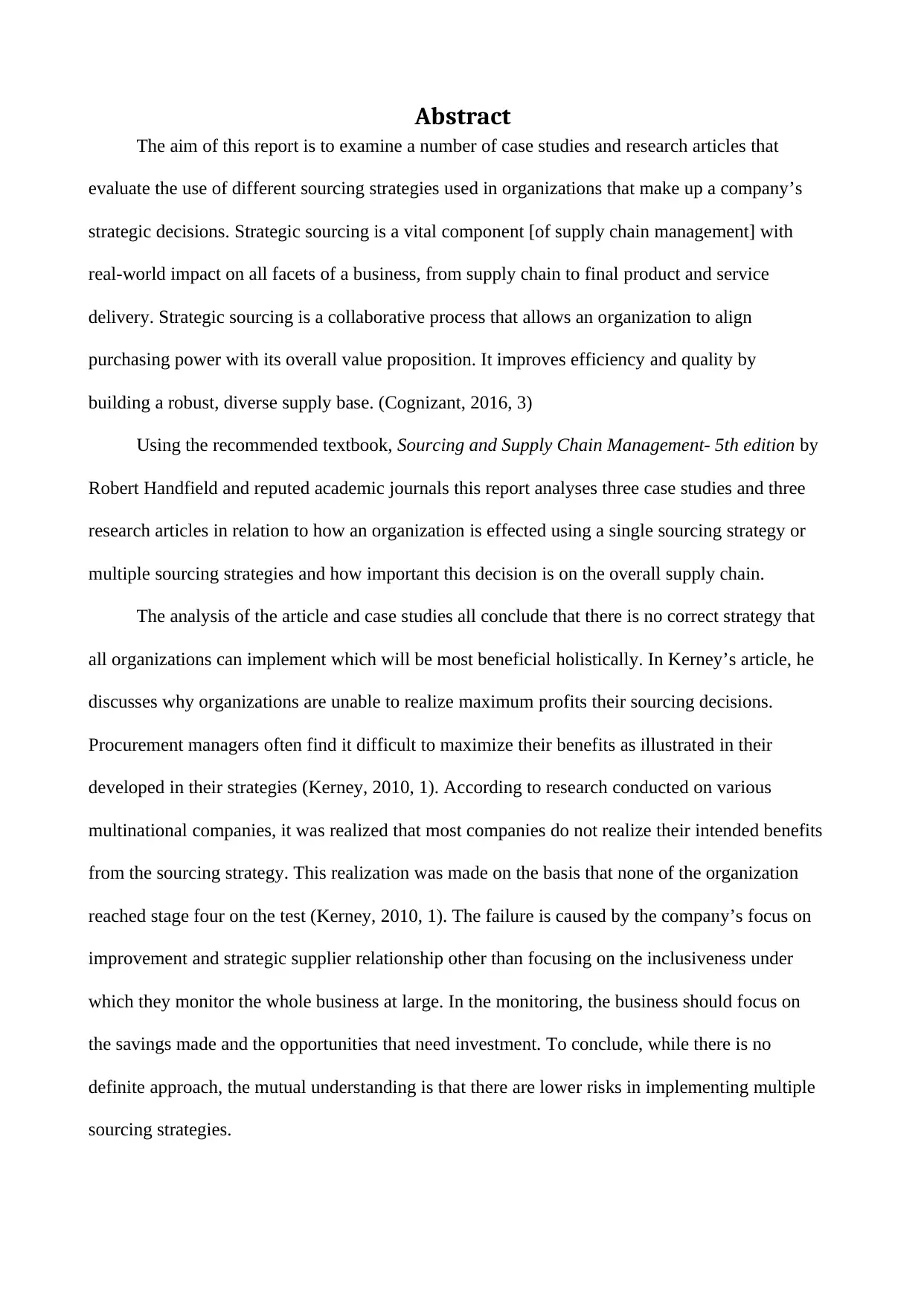
Abstract
The aim of this report is to examine a number of case studies and research articles that
evaluate the use of different sourcing strategies used in organizations that make up a company’s
strategic decisions. Strategic sourcing is a vital component [of supply chain management] with
real-world impact on all facets of a business, from supply chain to final product and service
delivery. Strategic sourcing is a collaborative process that allows an organization to align
purchasing power with its overall value proposition. It improves efficiency and quality by
building a robust, diverse supply base. (Cognizant, 2016, 3)
Using the recommended textbook, Sourcing and Supply Chain Management- 5th edition by
Robert Handfield and reputed academic journals this report analyses three case studies and three
research articles in relation to how an organization is effected using a single sourcing strategy or
multiple sourcing strategies and how important this decision is on the overall supply chain.
The analysis of the article and case studies all conclude that there is no correct strategy that
all organizations can implement which will be most beneficial holistically. In Kerney’s article, he
discusses why organizations are unable to realize maximum profits their sourcing decisions.
Procurement managers often find it difficult to maximize their benefits as illustrated in their
developed in their strategies (Kerney, 2010, 1). According to research conducted on various
multinational companies, it was realized that most companies do not realize their intended benefits
from the sourcing strategy. This realization was made on the basis that none of the organization
reached stage four on the test (Kerney, 2010, 1). The failure is caused by the company’s focus on
improvement and strategic supplier relationship other than focusing on the inclusiveness under
which they monitor the whole business at large. In the monitoring, the business should focus on
the savings made and the opportunities that need investment. To conclude, while there is no
definite approach, the mutual understanding is that there are lower risks in implementing multiple
sourcing strategies.
The aim of this report is to examine a number of case studies and research articles that
evaluate the use of different sourcing strategies used in organizations that make up a company’s
strategic decisions. Strategic sourcing is a vital component [of supply chain management] with
real-world impact on all facets of a business, from supply chain to final product and service
delivery. Strategic sourcing is a collaborative process that allows an organization to align
purchasing power with its overall value proposition. It improves efficiency and quality by
building a robust, diverse supply base. (Cognizant, 2016, 3)
Using the recommended textbook, Sourcing and Supply Chain Management- 5th edition by
Robert Handfield and reputed academic journals this report analyses three case studies and three
research articles in relation to how an organization is effected using a single sourcing strategy or
multiple sourcing strategies and how important this decision is on the overall supply chain.
The analysis of the article and case studies all conclude that there is no correct strategy that
all organizations can implement which will be most beneficial holistically. In Kerney’s article, he
discusses why organizations are unable to realize maximum profits their sourcing decisions.
Procurement managers often find it difficult to maximize their benefits as illustrated in their
developed in their strategies (Kerney, 2010, 1). According to research conducted on various
multinational companies, it was realized that most companies do not realize their intended benefits
from the sourcing strategy. This realization was made on the basis that none of the organization
reached stage four on the test (Kerney, 2010, 1). The failure is caused by the company’s focus on
improvement and strategic supplier relationship other than focusing on the inclusiveness under
which they monitor the whole business at large. In the monitoring, the business should focus on
the savings made and the opportunities that need investment. To conclude, while there is no
definite approach, the mutual understanding is that there are lower risks in implementing multiple
sourcing strategies.

Table of Contents
Abstract....................................................................................................................................................2
1.0 Introduction........................................................................................................................................3
2.0 Literature Review..............................................................................................................................4
2.1 Article 1: Single versus multiple supplier sourcing strategies.......................................................4
2.2 Article 2: Multiple or Single Sourcing? (Tullous and Utrecht, 1992)............................................5
2.3 Article 3: A risk/benefit analysis of sourcing strategies: Single vs. multiple sourcing..................6
3.0 Case Comparative Analysis...............................................................................................................7
3.1 Core problems of the case..............................................................................................................7
3.2 The comparative analysis and suggested solution..........................................................................8
References..............................................................................................................................................10
Abstract....................................................................................................................................................2
1.0 Introduction........................................................................................................................................3
2.0 Literature Review..............................................................................................................................4
2.1 Article 1: Single versus multiple supplier sourcing strategies.......................................................4
2.2 Article 2: Multiple or Single Sourcing? (Tullous and Utrecht, 1992)............................................5
2.3 Article 3: A risk/benefit analysis of sourcing strategies: Single vs. multiple sourcing..................6
3.0 Case Comparative Analysis...............................................................................................................7
3.1 Core problems of the case..............................................................................................................7
3.2 The comparative analysis and suggested solution..........................................................................8
References..............................................................................................................................................10
⊘ This is a preview!⊘
Do you want full access?
Subscribe today to unlock all pages.

Trusted by 1+ million students worldwide

1.0 Introduction
Successful supply chain management necessitates an effective sourcing strategy to combat
uncertainties in both supply and demand (Ambe, 2012, 128). Often organizations are left to choose
whether they should use single sourcing or multiple sourcing. There is no correct choice as both
have their own separate advantages and disadvantages. From the industry level viewpoint, single
sourcing may be more appropriate to use over multiple sourcing. In the same way, from a company
level viewpoint, single sourcing may be more suitable for certain organizations over another. The
case studies sourced from Sourcing and Supply Chain Management- 5th edition by Robert
Handfield and research articles found online to explore the advantages and disadvantages of using
single sourcing and multiple sourcing. The case studies also provide an insight into how some
companies supply chains are at risk of choosing the wrong sourcing method.
It is observed that small companies lean towards single sourcing meanwhile larger
companies tend to use multiple sourcing as the demand for inventory is higher and there are high
risks associated with single sourcing. The buying-selling situation of the firm is also a major
factor in deciding whether a company should a single source or not. If an organization aims to
have a steady flow of materials, they are recommended to lean towards using multiple suppliers
Successful supply chain management necessitates an effective sourcing strategy to combat
uncertainties in both supply and demand (Ambe, 2012, 128). Often organizations are left to choose
whether they should use single sourcing or multiple sourcing. There is no correct choice as both
have their own separate advantages and disadvantages. From the industry level viewpoint, single
sourcing may be more appropriate to use over multiple sourcing. In the same way, from a company
level viewpoint, single sourcing may be more suitable for certain organizations over another. The
case studies sourced from Sourcing and Supply Chain Management- 5th edition by Robert
Handfield and research articles found online to explore the advantages and disadvantages of using
single sourcing and multiple sourcing. The case studies also provide an insight into how some
companies supply chains are at risk of choosing the wrong sourcing method.
It is observed that small companies lean towards single sourcing meanwhile larger
companies tend to use multiple sourcing as the demand for inventory is higher and there are high
risks associated with single sourcing. The buying-selling situation of the firm is also a major
factor in deciding whether a company should a single source or not. If an organization aims to
have a steady flow of materials, they are recommended to lean towards using multiple suppliers
Paraphrase This Document
Need a fresh take? Get an instant paraphrase of this document with our AI Paraphraser

2.0 Literature Review
2.1 Article 1: Single versus multiple supplier sourcing strategies
This article evaluates the single and multiple sourcing strategies used in the supply chain by
“identifying when it is optimal for the manufacturer to use multiple suppliers versus a single
supplier” (Nafie, 2012, 1). most organization in the past considered having several suppliers. The
decision was reached at since it enhanced competition among the supplier which resulted to
reduction of supply cost to the company. The decision has been discouraged on the basis that it
prevents the good relationship between the suppliers which in return result to an increase in the
cost of supply. On the other hand, single sourcing has been discouraged since the supplier develops
a monopolistic advantage and increases the cost of his or her services.
The paper evaluates the strategies using an analytical approach assuming a zero-
diversification benefit which is the notion of an organization not gain any direct diversification
benefit when choosing to use more than one supplies and through this, the article creates five
theorems and calls them the benchmark. The paper uses the new vendor framework to ensure the
model created provides the optimal number of staff and optimal inventory in a specific time frame
to establish the ultimate number of suppliers needed to ensure all orders is accounted for and on
time.
The article argues that when using the single sourcing strategy, it is essential to strive for the
partnership between the buyers and suppliers to promote cooperation and provide each other with
shared benefits which can include prioritizing the buyer as the supplier for they are exclusively
sourcing through them or providing discounts for the bulk orders as they are again, the only supplier
to the firm. The relationship between supplier and buyer is vital as it fosters successful JIT inventory.
A very clear advantage of having one supplier is that it is more manageable than having multiple
suppliers.
However, a disadvantage of single sourcing is that it can never truly safeguard itself to hold-
up risk. By single sourcing, firms expose themselves to a monopolistic supply base, which can
easily affect their inventory if their relationship with their supplier is damaged. By choosing
2.1 Article 1: Single versus multiple supplier sourcing strategies
This article evaluates the single and multiple sourcing strategies used in the supply chain by
“identifying when it is optimal for the manufacturer to use multiple suppliers versus a single
supplier” (Nafie, 2012, 1). most organization in the past considered having several suppliers. The
decision was reached at since it enhanced competition among the supplier which resulted to
reduction of supply cost to the company. The decision has been discouraged on the basis that it
prevents the good relationship between the suppliers which in return result to an increase in the
cost of supply. On the other hand, single sourcing has been discouraged since the supplier develops
a monopolistic advantage and increases the cost of his or her services.
The paper evaluates the strategies using an analytical approach assuming a zero-
diversification benefit which is the notion of an organization not gain any direct diversification
benefit when choosing to use more than one supplies and through this, the article creates five
theorems and calls them the benchmark. The paper uses the new vendor framework to ensure the
model created provides the optimal number of staff and optimal inventory in a specific time frame
to establish the ultimate number of suppliers needed to ensure all orders is accounted for and on
time.
The article argues that when using the single sourcing strategy, it is essential to strive for the
partnership between the buyers and suppliers to promote cooperation and provide each other with
shared benefits which can include prioritizing the buyer as the supplier for they are exclusively
sourcing through them or providing discounts for the bulk orders as they are again, the only supplier
to the firm. The relationship between supplier and buyer is vital as it fosters successful JIT inventory.
A very clear advantage of having one supplier is that it is more manageable than having multiple
suppliers.
However, a disadvantage of single sourcing is that it can never truly safeguard itself to hold-
up risk. By single sourcing, firms expose themselves to a monopolistic supply base, which can
easily affect their inventory if their relationship with their supplier is damaged. By choosing
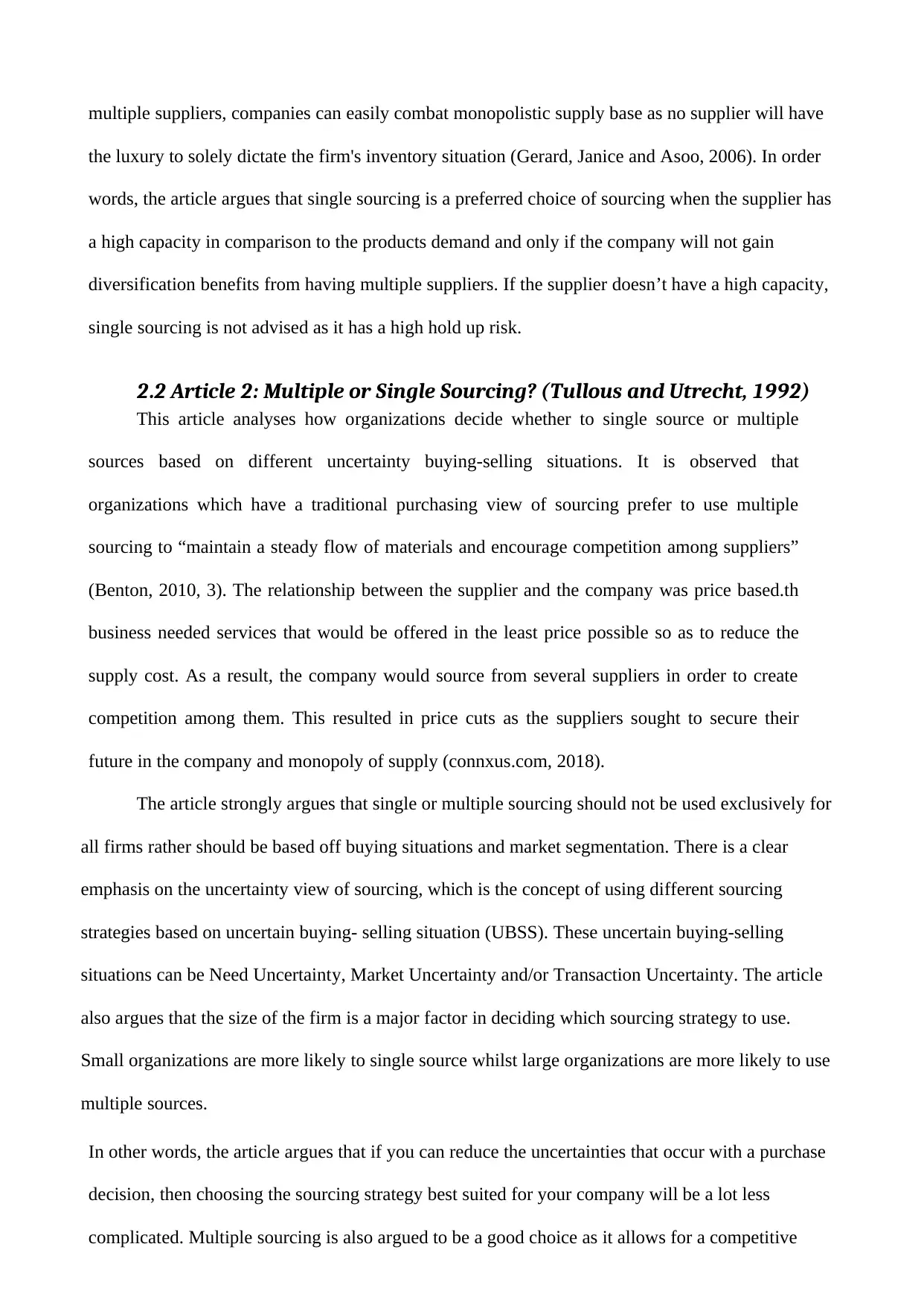
multiple suppliers, companies can easily combat monopolistic supply base as no supplier will have
the luxury to solely dictate the firm's inventory situation (Gerard, Janice and Asoo, 2006). In order
words, the article argues that single sourcing is a preferred choice of sourcing when the supplier has
a high capacity in comparison to the products demand and only if the company will not gain
diversification benefits from having multiple suppliers. If the supplier doesn’t have a high capacity,
single sourcing is not advised as it has a high hold up risk.
2.2 Article 2: Multiple or Single Sourcing? (Tullous and Utrecht, 1992)
This article analyses how organizations decide whether to single source or multiple
sources based on different uncertainty buying-selling situations. It is observed that
organizations which have a traditional purchasing view of sourcing prefer to use multiple
sourcing to “maintain a steady flow of materials and encourage competition among suppliers”
(Benton, 2010, 3). The relationship between the supplier and the company was price based.th
business needed services that would be offered in the least price possible so as to reduce the
supply cost. As a result, the company would source from several suppliers in order to create
competition among them. This resulted in price cuts as the suppliers sought to secure their
future in the company and monopoly of supply (connxus.com, 2018).
The article strongly argues that single or multiple sourcing should not be used exclusively for
all firms rather should be based off buying situations and market segmentation. There is a clear
emphasis on the uncertainty view of sourcing, which is the concept of using different sourcing
strategies based on uncertain buying- selling situation (UBSS). These uncertain buying-selling
situations can be Need Uncertainty, Market Uncertainty and/or Transaction Uncertainty. The article
also argues that the size of the firm is a major factor in deciding which sourcing strategy to use.
Small organizations are more likely to single source whilst large organizations are more likely to use
multiple sources.
In other words, the article argues that if you can reduce the uncertainties that occur with a purchase
decision, then choosing the sourcing strategy best suited for your company will be a lot less
complicated. Multiple sourcing is also argued to be a good choice as it allows for a competitive
the luxury to solely dictate the firm's inventory situation (Gerard, Janice and Asoo, 2006). In order
words, the article argues that single sourcing is a preferred choice of sourcing when the supplier has
a high capacity in comparison to the products demand and only if the company will not gain
diversification benefits from having multiple suppliers. If the supplier doesn’t have a high capacity,
single sourcing is not advised as it has a high hold up risk.
2.2 Article 2: Multiple or Single Sourcing? (Tullous and Utrecht, 1992)
This article analyses how organizations decide whether to single source or multiple
sources based on different uncertainty buying-selling situations. It is observed that
organizations which have a traditional purchasing view of sourcing prefer to use multiple
sourcing to “maintain a steady flow of materials and encourage competition among suppliers”
(Benton, 2010, 3). The relationship between the supplier and the company was price based.th
business needed services that would be offered in the least price possible so as to reduce the
supply cost. As a result, the company would source from several suppliers in order to create
competition among them. This resulted in price cuts as the suppliers sought to secure their
future in the company and monopoly of supply (connxus.com, 2018).
The article strongly argues that single or multiple sourcing should not be used exclusively for
all firms rather should be based off buying situations and market segmentation. There is a clear
emphasis on the uncertainty view of sourcing, which is the concept of using different sourcing
strategies based on uncertain buying- selling situation (UBSS). These uncertain buying-selling
situations can be Need Uncertainty, Market Uncertainty and/or Transaction Uncertainty. The article
also argues that the size of the firm is a major factor in deciding which sourcing strategy to use.
Small organizations are more likely to single source whilst large organizations are more likely to use
multiple sources.
In other words, the article argues that if you can reduce the uncertainties that occur with a purchase
decision, then choosing the sourcing strategy best suited for your company will be a lot less
complicated. Multiple sourcing is also argued to be a good choice as it allows for a competitive
⊘ This is a preview!⊘
Do you want full access?
Subscribe today to unlock all pages.

Trusted by 1+ million students worldwide
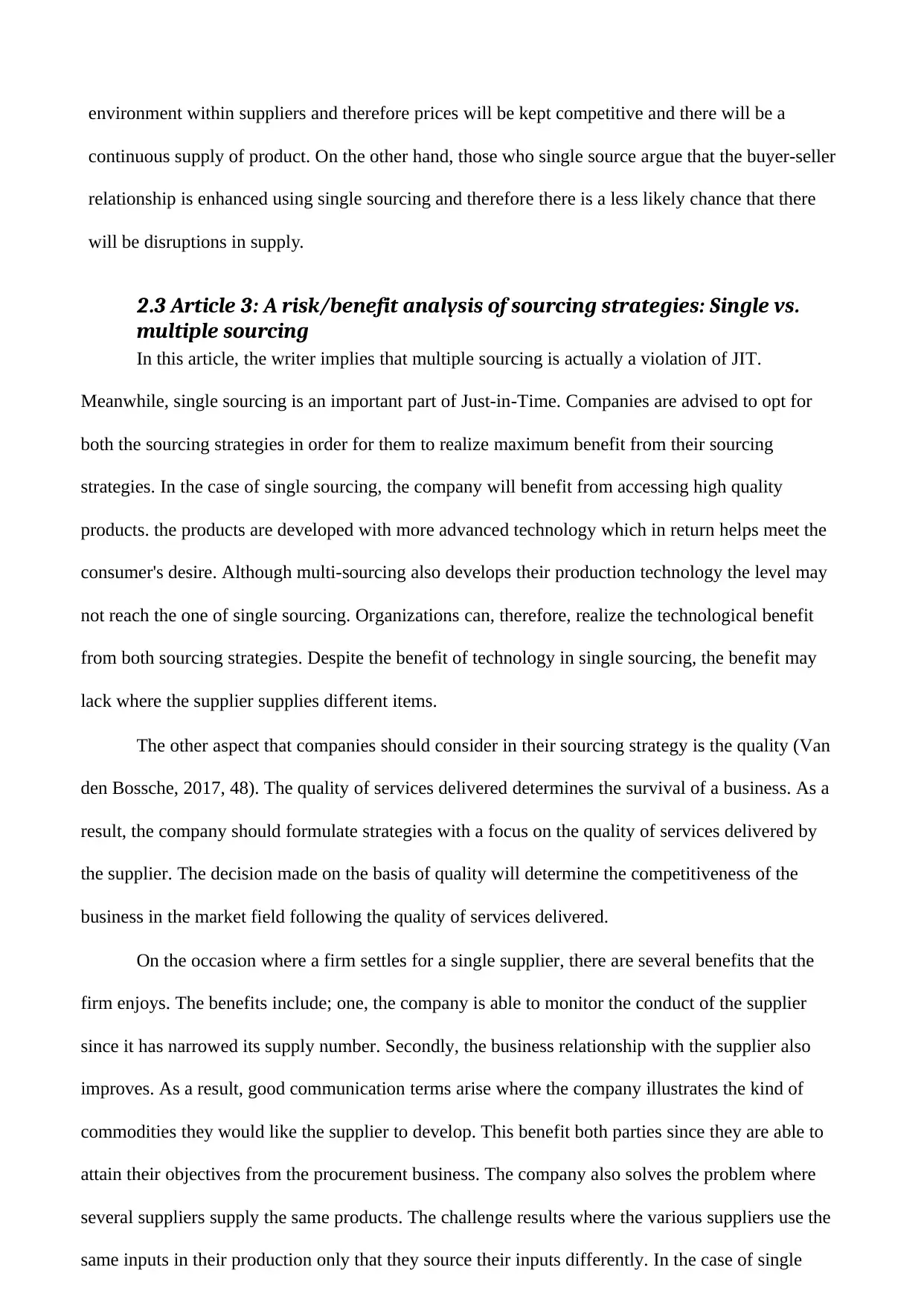
environment within suppliers and therefore prices will be kept competitive and there will be a
continuous supply of product. On the other hand, those who single source argue that the buyer-seller
relationship is enhanced using single sourcing and therefore there is a less likely chance that there
will be disruptions in supply.
2.3 Article 3: A risk/benefit analysis of sourcing strategies: Single vs.
multiple sourcing
In this article, the writer implies that multiple sourcing is actually a violation of JIT.
Meanwhile, single sourcing is an important part of Just-in-Time. Companies are advised to opt for
both the sourcing strategies in order for them to realize maximum benefit from their sourcing
strategies. In the case of single sourcing, the company will benefit from accessing high quality
products. the products are developed with more advanced technology which in return helps meet the
consumer's desire. Although multi-sourcing also develops their production technology the level may
not reach the one of single sourcing. Organizations can, therefore, realize the technological benefit
from both sourcing strategies. Despite the benefit of technology in single sourcing, the benefit may
lack where the supplier supplies different items.
The other aspect that companies should consider in their sourcing strategy is the quality (Van
den Bossche, 2017, 48). The quality of services delivered determines the survival of a business. As a
result, the company should formulate strategies with a focus on the quality of services delivered by
the supplier. The decision made on the basis of quality will determine the competitiveness of the
business in the market field following the quality of services delivered.
On the occasion where a firm settles for a single supplier, there are several benefits that the
firm enjoys. The benefits include; one, the company is able to monitor the conduct of the supplier
since it has narrowed its supply number. Secondly, the business relationship with the supplier also
improves. As a result, good communication terms arise where the company illustrates the kind of
commodities they would like the supplier to develop. This benefit both parties since they are able to
attain their objectives from the procurement business. The company also solves the problem where
several suppliers supply the same products. The challenge results where the various suppliers use the
same inputs in their production only that they source their inputs differently. In the case of single
continuous supply of product. On the other hand, those who single source argue that the buyer-seller
relationship is enhanced using single sourcing and therefore there is a less likely chance that there
will be disruptions in supply.
2.3 Article 3: A risk/benefit analysis of sourcing strategies: Single vs.
multiple sourcing
In this article, the writer implies that multiple sourcing is actually a violation of JIT.
Meanwhile, single sourcing is an important part of Just-in-Time. Companies are advised to opt for
both the sourcing strategies in order for them to realize maximum benefit from their sourcing
strategies. In the case of single sourcing, the company will benefit from accessing high quality
products. the products are developed with more advanced technology which in return helps meet the
consumer's desire. Although multi-sourcing also develops their production technology the level may
not reach the one of single sourcing. Organizations can, therefore, realize the technological benefit
from both sourcing strategies. Despite the benefit of technology in single sourcing, the benefit may
lack where the supplier supplies different items.
The other aspect that companies should consider in their sourcing strategy is the quality (Van
den Bossche, 2017, 48). The quality of services delivered determines the survival of a business. As a
result, the company should formulate strategies with a focus on the quality of services delivered by
the supplier. The decision made on the basis of quality will determine the competitiveness of the
business in the market field following the quality of services delivered.
On the occasion where a firm settles for a single supplier, there are several benefits that the
firm enjoys. The benefits include; one, the company is able to monitor the conduct of the supplier
since it has narrowed its supply number. Secondly, the business relationship with the supplier also
improves. As a result, good communication terms arise where the company illustrates the kind of
commodities they would like the supplier to develop. This benefit both parties since they are able to
attain their objectives from the procurement business. The company also solves the problem where
several suppliers supply the same products. The challenge results where the various suppliers use the
same inputs in their production only that they source their inputs differently. In the case of single
Paraphrase This Document
Need a fresh take? Get an instant paraphrase of this document with our AI Paraphraser
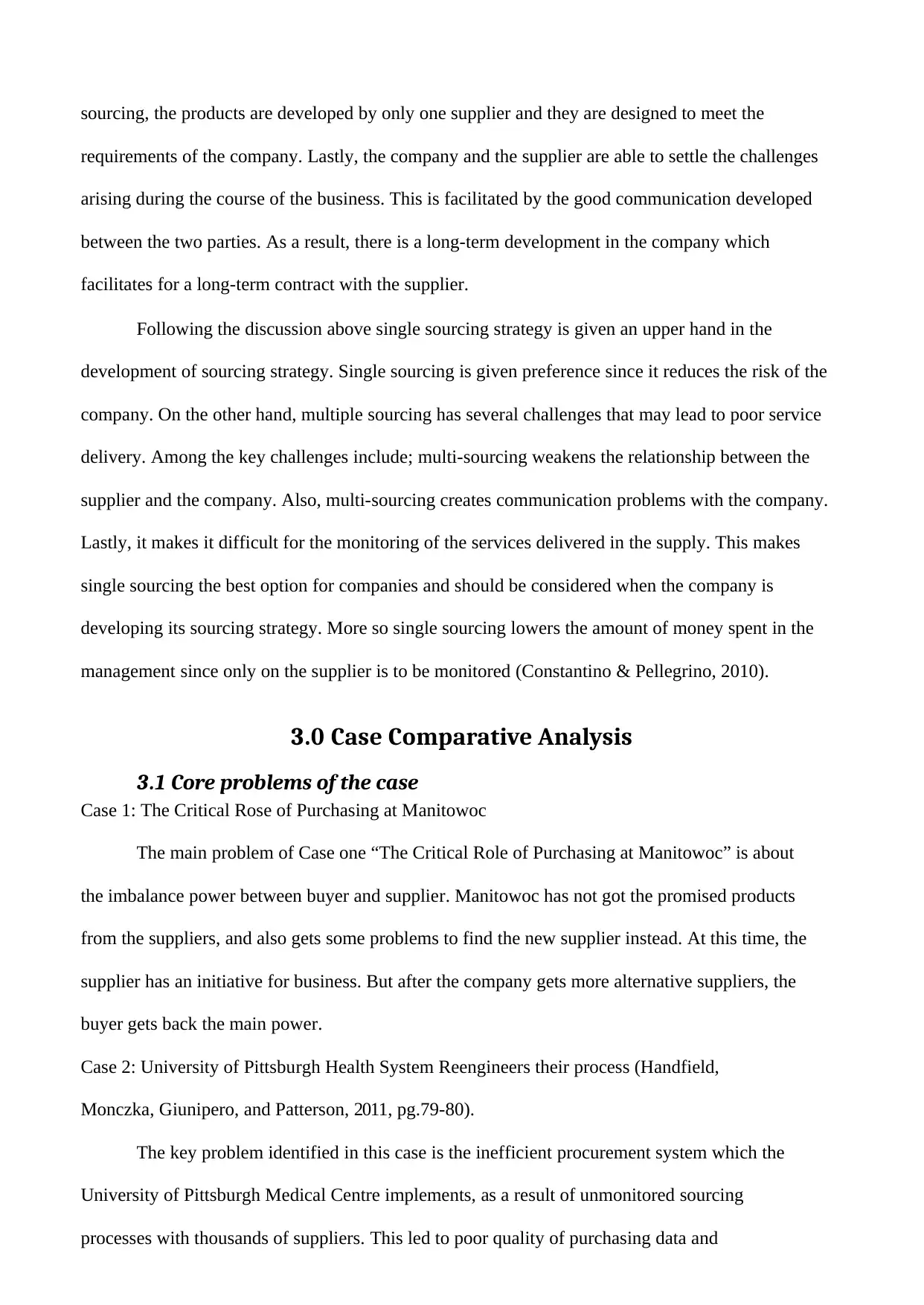
sourcing, the products are developed by only one supplier and they are designed to meet the
requirements of the company. Lastly, the company and the supplier are able to settle the challenges
arising during the course of the business. This is facilitated by the good communication developed
between the two parties. As a result, there is a long-term development in the company which
facilitates for a long-term contract with the supplier.
Following the discussion above single sourcing strategy is given an upper hand in the
development of sourcing strategy. Single sourcing is given preference since it reduces the risk of the
company. On the other hand, multiple sourcing has several challenges that may lead to poor service
delivery. Among the key challenges include; multi-sourcing weakens the relationship between the
supplier and the company. Also, multi-sourcing creates communication problems with the company.
Lastly, it makes it difficult for the monitoring of the services delivered in the supply. This makes
single sourcing the best option for companies and should be considered when the company is
developing its sourcing strategy. More so single sourcing lowers the amount of money spent in the
management since only on the supplier is to be monitored (Constantino & Pellegrino, 2010).
3.0 Case Comparative Analysis
3.1 Core problems of the case
Case 1: The Critical Rose of Purchasing at Manitowoc
The main problem of Case one “The Critical Role of Purchasing at Manitowoc” is about
the imbalance power between buyer and supplier. Manitowoc has not got the promised products
from the suppliers, and also gets some problems to find the new supplier instead. At this time, the
supplier has an initiative for business. But after the company gets more alternative suppliers, the
buyer gets back the main power.
Case 2: University of Pittsburgh Health System Reengineers their process (Handfield,
Monczka, Giunipero, and Patterson, 2011, pg.79-80).
The key problem identified in this case is the inefficient procurement system which the
University of Pittsburgh Medical Centre implements, as a result of unmonitored sourcing
processes with thousands of suppliers. This led to poor quality of purchasing data and
requirements of the company. Lastly, the company and the supplier are able to settle the challenges
arising during the course of the business. This is facilitated by the good communication developed
between the two parties. As a result, there is a long-term development in the company which
facilitates for a long-term contract with the supplier.
Following the discussion above single sourcing strategy is given an upper hand in the
development of sourcing strategy. Single sourcing is given preference since it reduces the risk of the
company. On the other hand, multiple sourcing has several challenges that may lead to poor service
delivery. Among the key challenges include; multi-sourcing weakens the relationship between the
supplier and the company. Also, multi-sourcing creates communication problems with the company.
Lastly, it makes it difficult for the monitoring of the services delivered in the supply. This makes
single sourcing the best option for companies and should be considered when the company is
developing its sourcing strategy. More so single sourcing lowers the amount of money spent in the
management since only on the supplier is to be monitored (Constantino & Pellegrino, 2010).
3.0 Case Comparative Analysis
3.1 Core problems of the case
Case 1: The Critical Rose of Purchasing at Manitowoc
The main problem of Case one “The Critical Role of Purchasing at Manitowoc” is about
the imbalance power between buyer and supplier. Manitowoc has not got the promised products
from the suppliers, and also gets some problems to find the new supplier instead. At this time, the
supplier has an initiative for business. But after the company gets more alternative suppliers, the
buyer gets back the main power.
Case 2: University of Pittsburgh Health System Reengineers their process (Handfield,
Monczka, Giunipero, and Patterson, 2011, pg.79-80).
The key problem identified in this case is the inefficient procurement system which the
University of Pittsburgh Medical Centre implements, as a result of unmonitored sourcing
processes with thousands of suppliers. This led to poor quality of purchasing data and
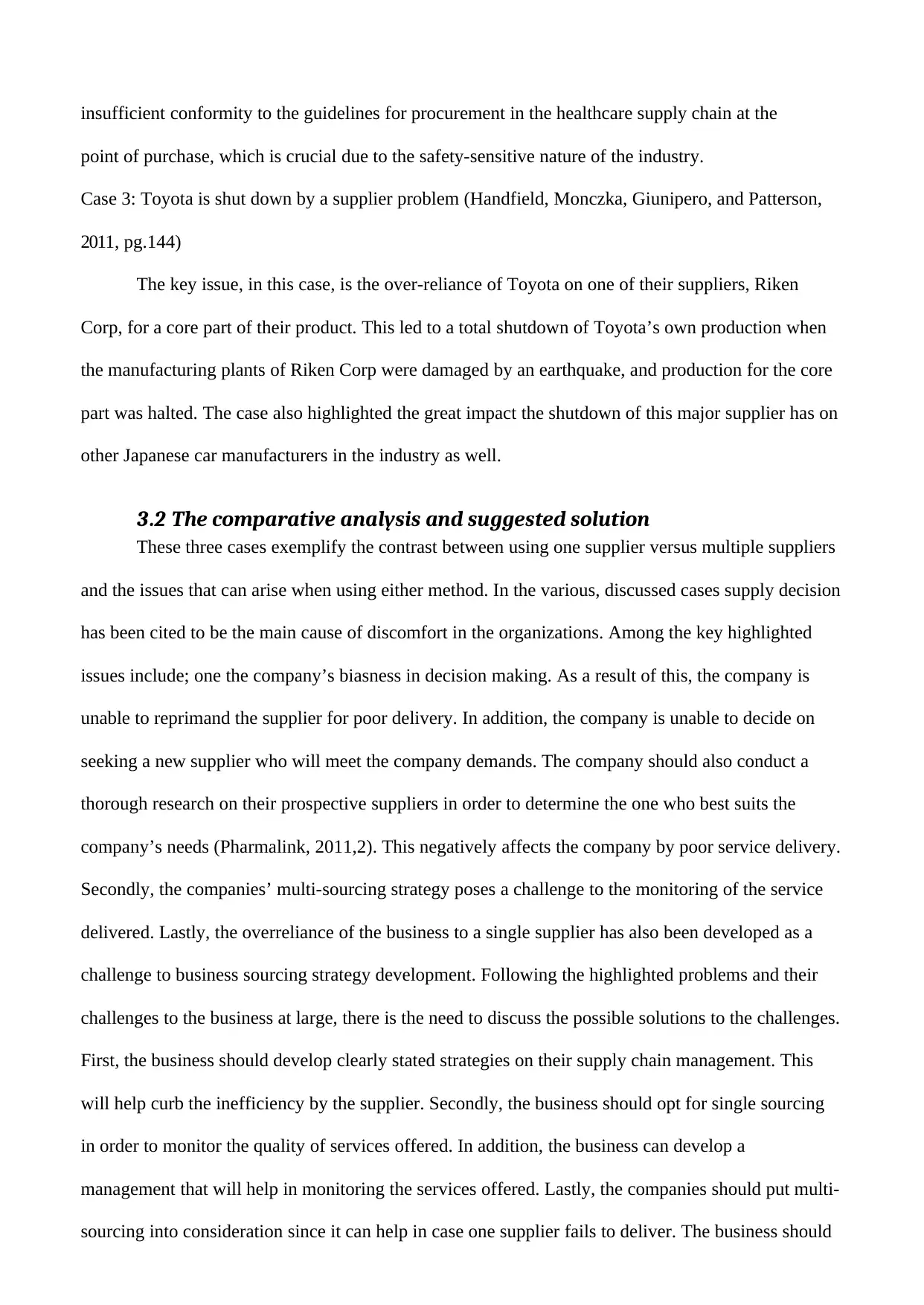
insufficient conformity to the guidelines for procurement in the healthcare supply chain at the
point of purchase, which is crucial due to the safety-sensitive nature of the industry.
Case 3: Toyota is shut down by a supplier problem (Handfield, Monczka, Giunipero, and Patterson,
2011, pg.144)
The key issue, in this case, is the over-reliance of Toyota on one of their suppliers, Riken
Corp, for a core part of their product. This led to a total shutdown of Toyota’s own production when
the manufacturing plants of Riken Corp were damaged by an earthquake, and production for the core
part was halted. The case also highlighted the great impact the shutdown of this major supplier has on
other Japanese car manufacturers in the industry as well.
3.2 The comparative analysis and suggested solution
These three cases exemplify the contrast between using one supplier versus multiple suppliers
and the issues that can arise when using either method. In the various, discussed cases supply decision
has been cited to be the main cause of discomfort in the organizations. Among the key highlighted
issues include; one the company’s biasness in decision making. As a result of this, the company is
unable to reprimand the supplier for poor delivery. In addition, the company is unable to decide on
seeking a new supplier who will meet the company demands. The company should also conduct a
thorough research on their prospective suppliers in order to determine the one who best suits the
company’s needs (Pharmalink, 2011,2). This negatively affects the company by poor service delivery.
Secondly, the companies’ multi-sourcing strategy poses a challenge to the monitoring of the service
delivered. Lastly, the overreliance of the business to a single supplier has also been developed as a
challenge to business sourcing strategy development. Following the highlighted problems and their
challenges to the business at large, there is the need to discuss the possible solutions to the challenges.
First, the business should develop clearly stated strategies on their supply chain management. This
will help curb the inefficiency by the supplier. Secondly, the business should opt for single sourcing
in order to monitor the quality of services offered. In addition, the business can develop a
management that will help in monitoring the services offered. Lastly, the companies should put multi-
sourcing into consideration since it can help in case one supplier fails to deliver. The business should
point of purchase, which is crucial due to the safety-sensitive nature of the industry.
Case 3: Toyota is shut down by a supplier problem (Handfield, Monczka, Giunipero, and Patterson,
2011, pg.144)
The key issue, in this case, is the over-reliance of Toyota on one of their suppliers, Riken
Corp, for a core part of their product. This led to a total shutdown of Toyota’s own production when
the manufacturing plants of Riken Corp were damaged by an earthquake, and production for the core
part was halted. The case also highlighted the great impact the shutdown of this major supplier has on
other Japanese car manufacturers in the industry as well.
3.2 The comparative analysis and suggested solution
These three cases exemplify the contrast between using one supplier versus multiple suppliers
and the issues that can arise when using either method. In the various, discussed cases supply decision
has been cited to be the main cause of discomfort in the organizations. Among the key highlighted
issues include; one the company’s biasness in decision making. As a result of this, the company is
unable to reprimand the supplier for poor delivery. In addition, the company is unable to decide on
seeking a new supplier who will meet the company demands. The company should also conduct a
thorough research on their prospective suppliers in order to determine the one who best suits the
company’s needs (Pharmalink, 2011,2). This negatively affects the company by poor service delivery.
Secondly, the companies’ multi-sourcing strategy poses a challenge to the monitoring of the service
delivered. Lastly, the overreliance of the business to a single supplier has also been developed as a
challenge to business sourcing strategy development. Following the highlighted problems and their
challenges to the business at large, there is the need to discuss the possible solutions to the challenges.
First, the business should develop clearly stated strategies on their supply chain management. This
will help curb the inefficiency by the supplier. Secondly, the business should opt for single sourcing
in order to monitor the quality of services offered. In addition, the business can develop a
management that will help in monitoring the services offered. Lastly, the companies should put multi-
sourcing into consideration since it can help in case one supplier fails to deliver. The business should
⊘ This is a preview!⊘
Do you want full access?
Subscribe today to unlock all pages.

Trusted by 1+ million students worldwide
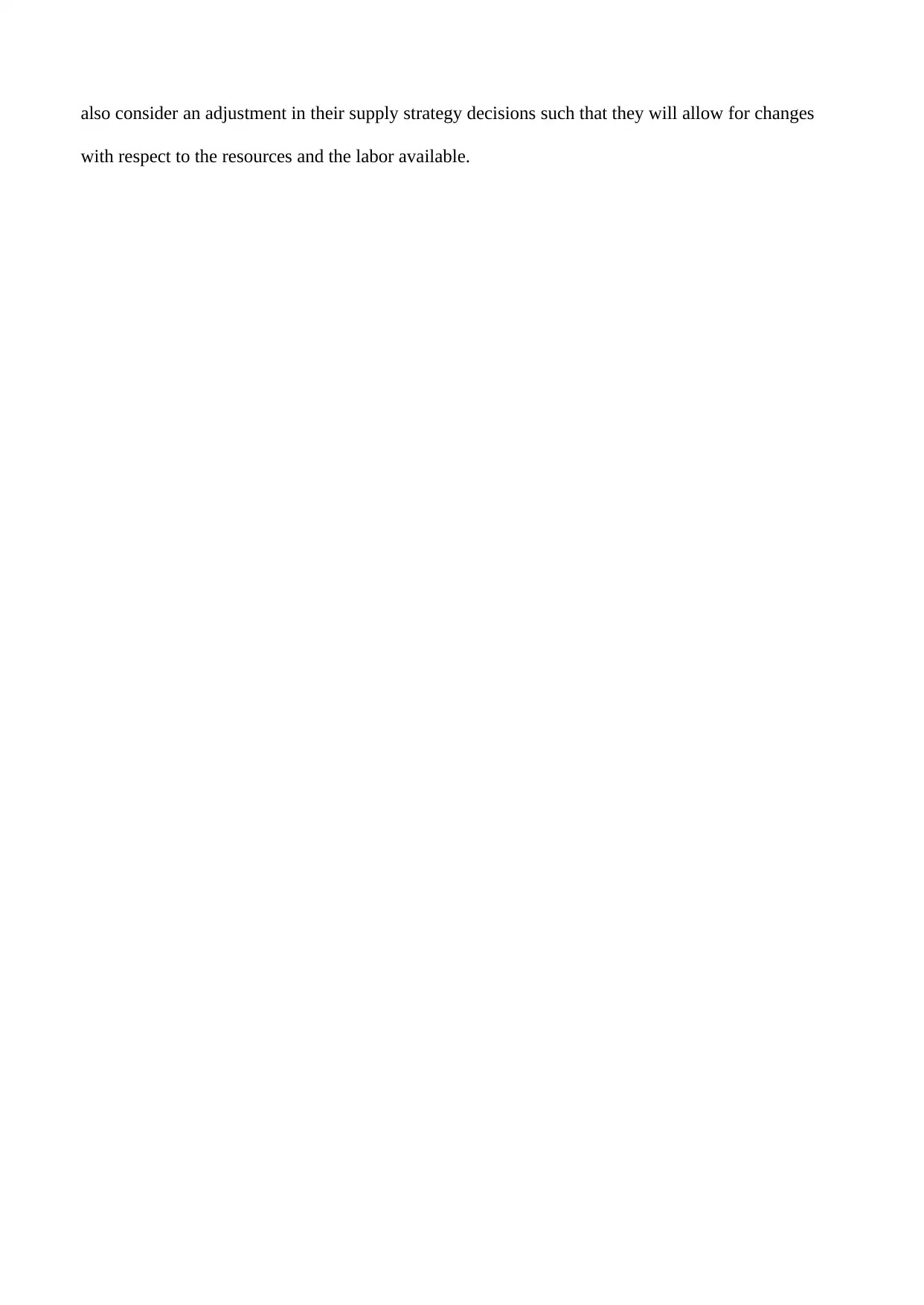
also consider an adjustment in their supply strategy decisions such that they will allow for changes
with respect to the resources and the labor available.
with respect to the resources and the labor available.
Paraphrase This Document
Need a fresh take? Get an instant paraphrase of this document with our AI Paraphraser
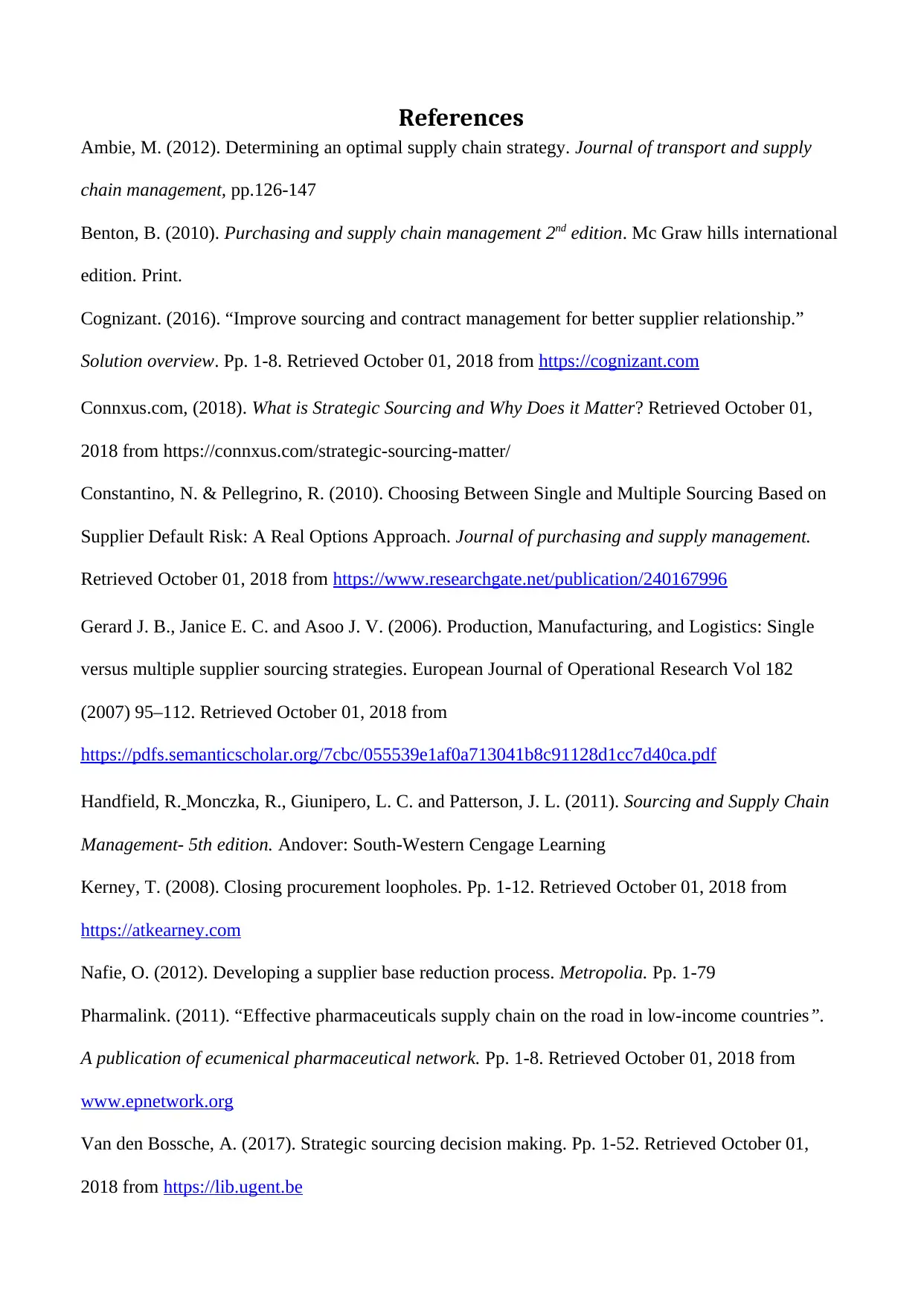
References
Ambie, M. (2012). Determining an optimal supply chain strategy. Journal of transport and supply
chain management, pp.126-147
Benton, B. (2010). Purchasing and supply chain management 2nd edition. Mc Graw hills international
edition. Print.
Cognizant. (2016). “Improve sourcing and contract management for better supplier relationship.”
Solution overview. Pp. 1-8. Retrieved October 01, 2018 from https://cognizant.com
Connxus.com, (2018). What is Strategic Sourcing and Why Does it Matter? Retrieved October 01,
2018 from https://connxus.com/strategic-sourcing-matter/
Constantino, N. & Pellegrino, R. (2010). Choosing Between Single and Multiple Sourcing Based on
Supplier Default Risk: A Real Options Approach. Journal of purchasing and supply management.
Retrieved October 01, 2018 from https://www.researchgate.net/publication/240167996
Gerard J. B., Janice E. C. and Asoo J. V. (2006). Production, Manufacturing, and Logistics: Single
versus multiple supplier sourcing strategies. European Journal of Operational Research Vol 182
(2007) 95–112. Retrieved October 01, 2018 from
https://pdfs.semanticscholar.org/7cbc/055539e1af0a713041b8c91128d1cc7d40ca.pdf
Handfield, R. Monczka, R., Giunipero, L. C. and Patterson, J. L. (2011). Sourcing and Supply Chain
Management- 5th edition. Andover: South-Western Cengage Learning
Kerney, T. (2008). Closing procurement loopholes. Pp. 1-12. Retrieved October 01, 2018 from
https://atkearney.com
Nafie, O. (2012). Developing a supplier base reduction process. Metropolia. Pp. 1-79
Pharmalink. (2011). “Effective pharmaceuticals supply chain on the road in low-income countries”.
A publication of ecumenical pharmaceutical network. Pp. 1-8. Retrieved October 01, 2018 from
www.epnetwork.org
Van den Bossche, A. (2017). Strategic sourcing decision making. Pp. 1-52. Retrieved October 01,
2018 from https://lib.ugent.be
Ambie, M. (2012). Determining an optimal supply chain strategy. Journal of transport and supply
chain management, pp.126-147
Benton, B. (2010). Purchasing and supply chain management 2nd edition. Mc Graw hills international
edition. Print.
Cognizant. (2016). “Improve sourcing and contract management for better supplier relationship.”
Solution overview. Pp. 1-8. Retrieved October 01, 2018 from https://cognizant.com
Connxus.com, (2018). What is Strategic Sourcing and Why Does it Matter? Retrieved October 01,
2018 from https://connxus.com/strategic-sourcing-matter/
Constantino, N. & Pellegrino, R. (2010). Choosing Between Single and Multiple Sourcing Based on
Supplier Default Risk: A Real Options Approach. Journal of purchasing and supply management.
Retrieved October 01, 2018 from https://www.researchgate.net/publication/240167996
Gerard J. B., Janice E. C. and Asoo J. V. (2006). Production, Manufacturing, and Logistics: Single
versus multiple supplier sourcing strategies. European Journal of Operational Research Vol 182
(2007) 95–112. Retrieved October 01, 2018 from
https://pdfs.semanticscholar.org/7cbc/055539e1af0a713041b8c91128d1cc7d40ca.pdf
Handfield, R. Monczka, R., Giunipero, L. C. and Patterson, J. L. (2011). Sourcing and Supply Chain
Management- 5th edition. Andover: South-Western Cengage Learning
Kerney, T. (2008). Closing procurement loopholes. Pp. 1-12. Retrieved October 01, 2018 from
https://atkearney.com
Nafie, O. (2012). Developing a supplier base reduction process. Metropolia. Pp. 1-79
Pharmalink. (2011). “Effective pharmaceuticals supply chain on the road in low-income countries”.
A publication of ecumenical pharmaceutical network. Pp. 1-8. Retrieved October 01, 2018 from
www.epnetwork.org
Van den Bossche, A. (2017). Strategic sourcing decision making. Pp. 1-52. Retrieved October 01,
2018 from https://lib.ugent.be

⊘ This is a preview!⊘
Do you want full access?
Subscribe today to unlock all pages.

Trusted by 1+ million students worldwide
1 out of 15
Related Documents
Your All-in-One AI-Powered Toolkit for Academic Success.
+13062052269
info@desklib.com
Available 24*7 on WhatsApp / Email
![[object Object]](/_next/static/media/star-bottom.7253800d.svg)
Unlock your academic potential
Copyright © 2020–2025 A2Z Services. All Rights Reserved. Developed and managed by ZUCOL.





